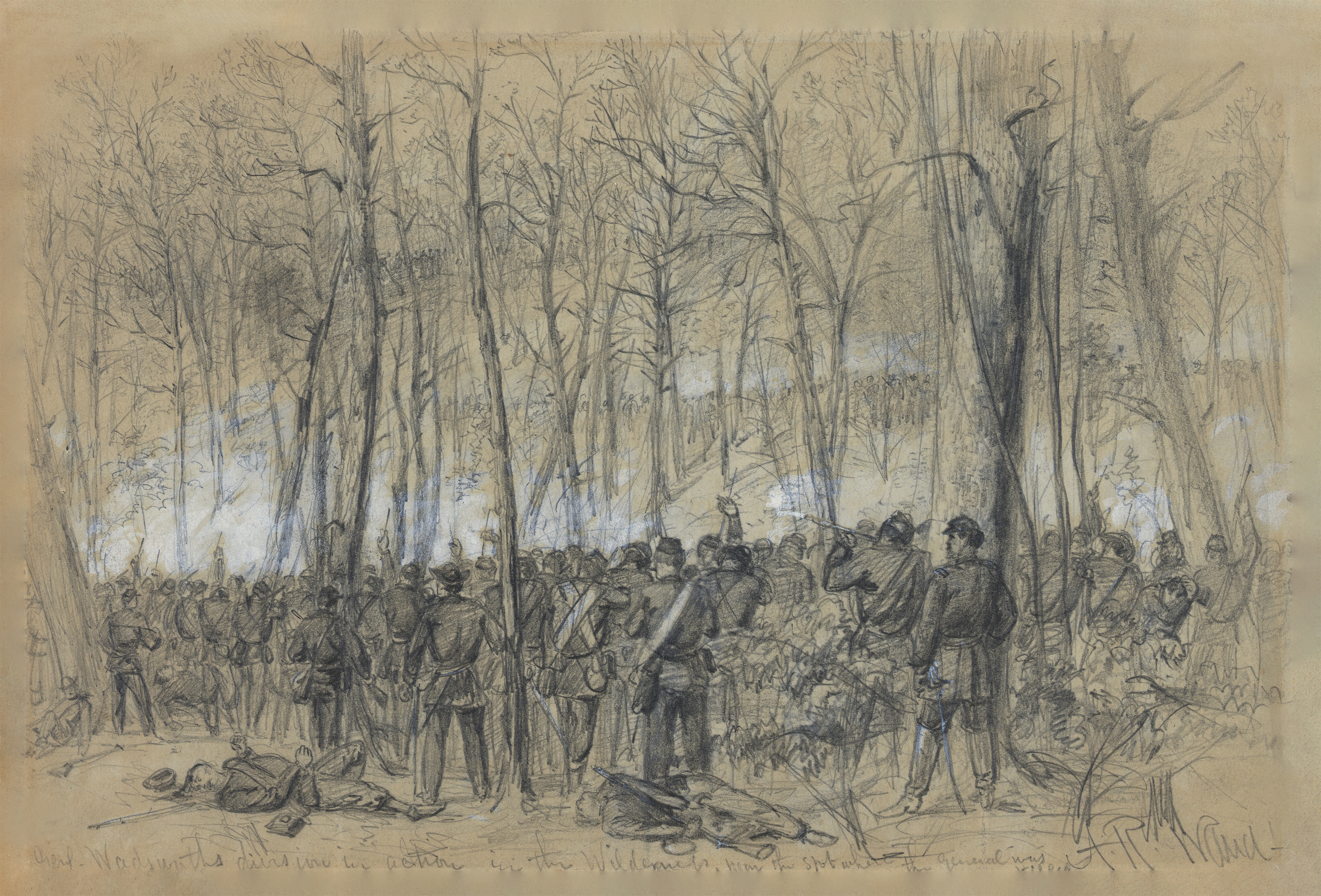A common farmer from Virginia and a millionaire general from new York transcended the horrors of the wilderness through simple acts of decency
By mid-morning May 6, 1864, Brig. Gen. James Samuel Wadsworth had endured a rough 24 hours in Virginia’s Wilderness. It was about to get tragically worse.
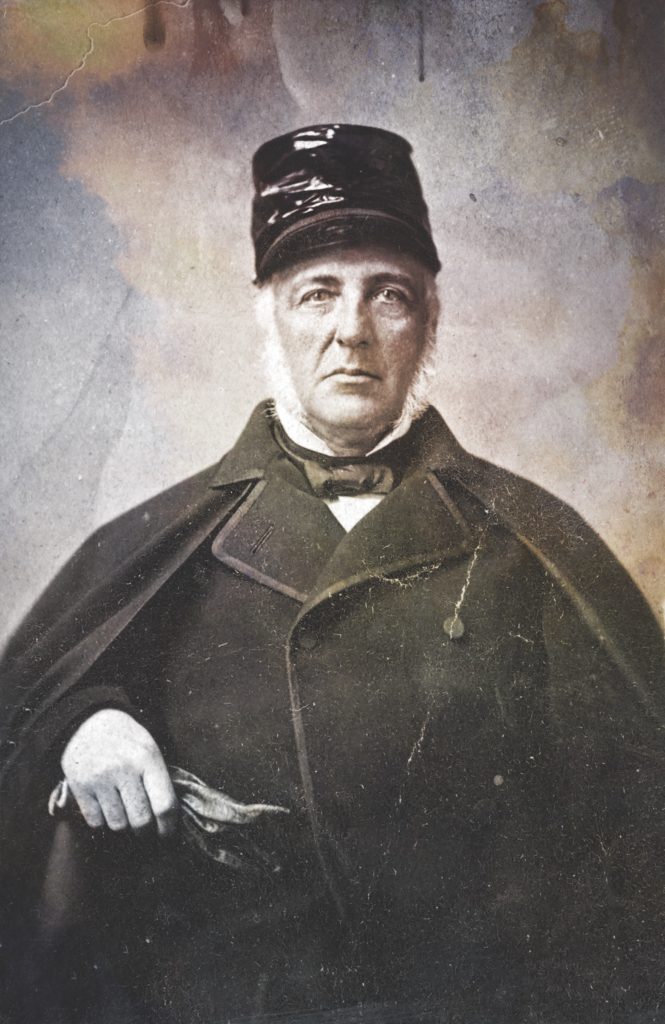
The previous day, when Union and Confederate forces opened on each other in the tangled, second-growth forest just west of Chancellorsville, Wadsworth advanced his bluecoats—members of the 4th Division, 5th Corps—into “the dark, trammeling woods” and quickly fell afoul not only of Confederates but also the terrain. Later, after the division regrouped in the open fields around 5th Corps headquarters, corps commander Maj. Gen. Gouverneur K. Warren sent them back in again. Wadsworth once more pushed through the dense foliage, arrowing straight toward an unguarded gap in the Confederate line near the Orange Plank Road. A surprise counterattack by the 5th Alabama Battalion sent the division scrambling rearward for the second time that day.
Despite the setbacks, Wadsworth “was conspicuous beyond all others for his gallantry, prompter than all others in leading his troops again and again into action,” noted Army of the Potomac chief of staff Maj. Gen. Andrew A. Humphreys. Now, on May 6, the 56-year-old Wadsworth faced his most severe crisis yet—and from it would emerge one of the most unlikely stories of human decency displayed during the entire war.
A 4:30 a.m. assault led by Union Maj. Gen. Winfield S. Hancock’s 2nd Corps, centered on the Orange Plank Road, had driven exhausted Confederates back more than a mile. Positioned as support, Wadsworth swung his division down from the northeast to help protect Hancock’s flank. But even as the entire right wing of the Rebel army faced annihilation, Wadsworth’s men became ensnarled with advancing troops from the 2nd Corps, necessitating a halt to sort things out.
Then the timely arrival of Lt. Gen. James Longstreet’s Corps reversed the momentum and the Federals
found themselves falling back pell-mell. Brigadier General Lysander Cutler, whose 1st Brigade broke under the onslaught, tried to find Wadsworth, his division commander, amid the chaos. Instead, he found a pair of the general’s aides and the divisional headquarters flag. Wadsworth’s horse had been killed in the assault, leading the men to believe Wadsworth had been slain as well.
But Wadsworth reappeared atop a new horse, apparently risen from the dead. He was always at the front, attested a member of the 150th Pennsylvania Infantry, urging his men on in an almost fatherly way. The general carried “hat in hand, bringing it down on the pommel of his saddle with every bound” as he moved among the troops, “speaking kindly to them, with ever a smile on his pleasant countenance which shows no concern for the storm of lead and iron raging around him.”
Hancock, desperately trying to repulse the Confederate attack, placed Wadsworth in command of all Federal soldiers on the north side of the Orange Plank Road while Hancock tried to direct efforts south of the road.
Meanwhile, Longstreet followed his initial assault with an attack launched from an unfinished railroad cut that ran along the unprotected Federal left flank. Volleys of Rebel musketry “resembled the fury of hell in intensity,” said one Union soldier, as the Confederates swarmed out of the cut.
The silver-haired Wadsworth, riding along the Plank Road, “was absolutely fearless in exposing himself to danger,” desperately trying to meet the threat to his left flank. Working to stabilize the situation, he repositioned the 56th Pennsylvania and 76th New York to face south, in essence refusing his left flank. He ordered Brig. Gen. Alexander Webb’s 2nd Corps brigade to take up a position parallel to the Plank Road and bolstered this improvised line with the 56th and 57th Massachusetts from Maj. Gen. Ambrose Burnside’s newly arrived 9th Corps.
As Wadsworth met this threat, Longstreet advanced elements of three Confederate divisions eastward along the Plank Road and into the Federal lines. The veteran 20th Massachusetts Infantry—the so-called “Harvard Regiment”—stalwartly faced the oncoming assault from behind an improvised barricade.
Riding over, Wadsworth called out, “What are you doing there? Who commands here? Colonel George Macy stepped forward and responded, “I do. And have been placed here by General Webb to hold this position at any cost.” With Longstreet bearing down, and with no other way to blunt the Confederate advance, Wadsworth ordered the 20th Massachusetts forward, directly at the Rebels, in what was surely a forlorn assault.
Macy reminded Wadsworth that his men belonged to the 2nd Corps, not the 5th, but was quickly rebuked.
“Very well, sir,” Macy responded, “we will go.” Satisfied, Wadsworth went off in search of other Bay State soldiers to send into the fray. As he left, Macy declared, “Great God! That man is out of his mind.”
But, dutifully, those hardened veterans of Antietam’s West Woods, the upper river crossing at Fredericksburg, and the famous stone wall at Gettysburg surged forward to their demise. The 8th Alabama Infantry lay in wait, not firing until they “saw the whites of their eyes,” one of the Alabamians said. Scores of Bay State soldiers fell in the ensuing firefight, including Macy, wounded in both legs.
Wadsworth, meanwhile, continued to press the fight. Frustrated, he was nevertheless nearly omnipresent among the hodgepodge units north of the road. “The roll of musketry sounded like the rumbling and pealing of thunder,” recalled Corporal James Donnelly. Small arms fire felled trees all around “as if they had been cut by a machine.” Wadsworth “seemed to be unconscious of the great danger,” one man observed.
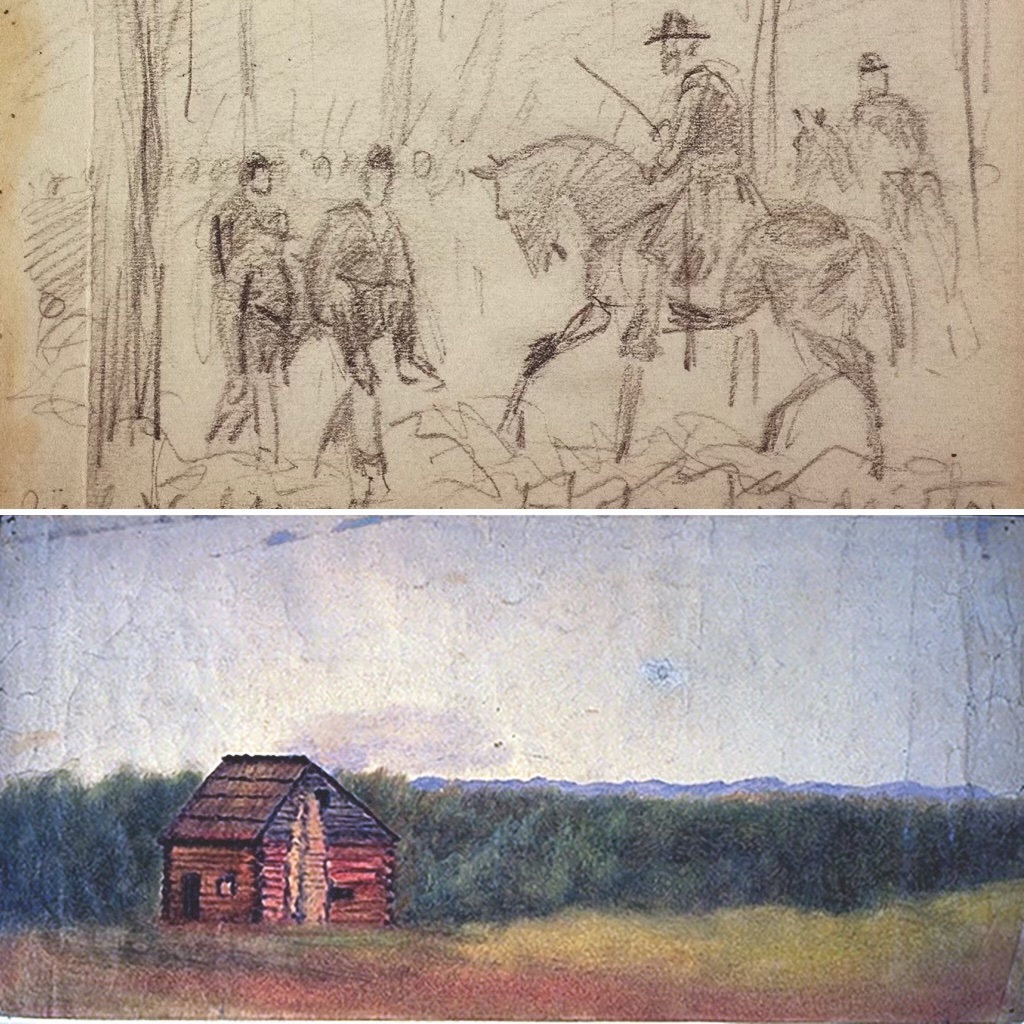
But in this cacophony of battle, Wadsworth’s horse was not unconscious of the danger. The second horse he had mounted during the battle, this replacement might not have been familiar to the general. Spooked, it took flight—galloping toward the enemy lines as Wadsworth struggled to regain control.
Within pistol range of the enemy lines, Wadsworth managed to turn the frightened beast around, and he and an aide, Lieutenant Earl Rogers, dashed back toward the safety of the flagging Union lines. Confederate small arms fire erupted. One bullet struck Rogers’ horse, felling the animal. Another struck Wadsworth in the head, spattering the general’s brain, blood, and skull fragments over the young aide.
Moments later, as Confederates drove their attack forward, Wadsworth—inert but still alive—lay helpless behind enemy lines.
At first, Wadsworth seemed an unlikely war hero, although there’s no denying he was destined for great accomplishments of some sort. Born on October 30, 1807, in Geneseo, N.Y., his well-to-do family had ties to George Washington’s army during the American Revolution.
Wadsworth attended both Harvard and Yale. In 1828, he read law under the tutelage of Senator Daniel Webster and passed the bar in 1833. On May 11, 1834, Wadsworth married Mary Craig Wharton in her native Philadelphia—a union that produced six children, including Craig Wadsworth, an aide to Brig. Gen. Alfred T.A. Torbert at the time of the Battle of the Wilderness.
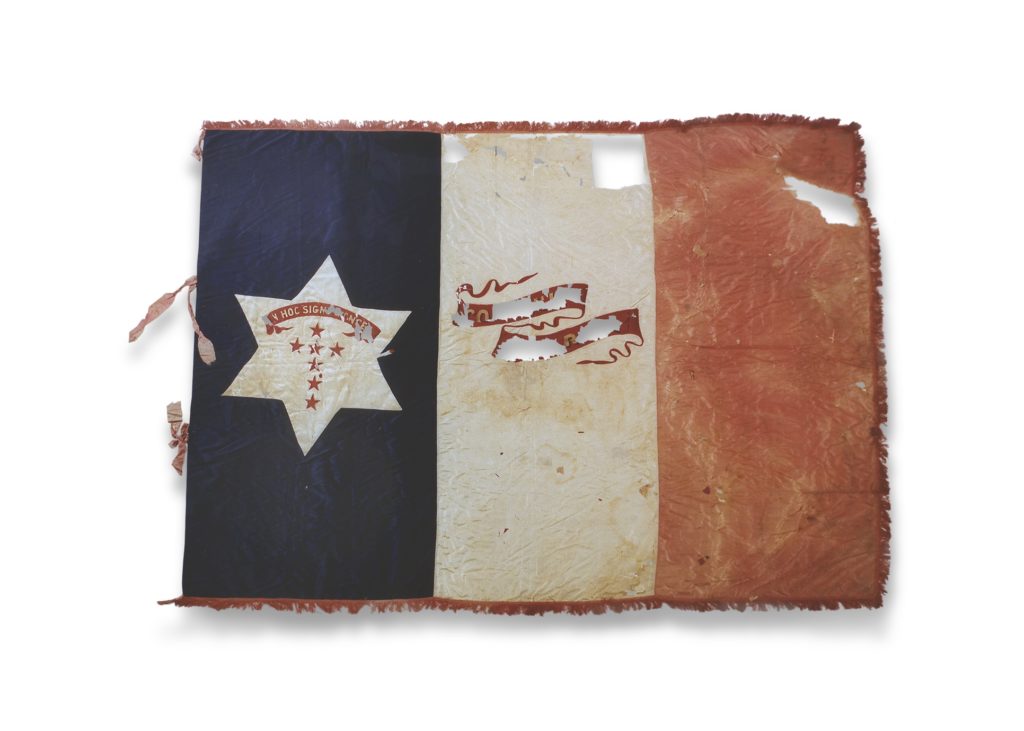
But the practice of law did not entice James Wadsworth, who instead turned to politics, philanthropy, and other ventures, including directorship of the Genesee Valley Bank and Genesee Valley Railroad Company. During the political tumult of the 1850s, Wadsworth was both an abolitionist and a Democrat; the tension between those two stances led him to the newly forming Republican Party. He was a presidential elector in 1856 and 1860, backing John C. Frémont in 1856 and strongly backing Abraham Lincoln in 1860—something Lincoln did not forget.
With the outbreak of war, Wadsworth was appointed to the rank of major in the New York State Militia. His sense of noblesse oblige inspired him soon thereafter to volunteer his services, without pay, to the new Federal army commander in Washington, Brig. Gen. Irvin McDowell. He served as an aide on McDowell’s staff at the First Battle of Bull Run. “Wadsworth is active,” one officer quipped, “always busy at something, and with a good allowance of common sense, but knows nothing of military matters.”
Lincoln rewarded Wadsworth’s political loyalty first by naming him military governor of the District of Columbia and later, in December 1862, by assigning him to field command of the 1st Division in the Army of the Potomac’s 1st Corps.
By May 1864, Wadsworth had amassed a solid fighting résumé. He led men into action at the May 1863 Second Battle of Fredericksburg, where he rode in one of the lead boats crossing the Rappahannock River under fire, with his horse swimming behind in tow. Two months later at Gettysburg, his division was the first Federal infantry to arrive on the field, and his men saw action on all three days of the battle.
As Captain Charles Hall of the 2nd Maine Light Battery said, speaking for many admirers, Wadsworth proved himself a “glorious man. A braver man never lived.”
During the May 6 fight along the Orange Plank Road, P.D. Bowles of the 4th Alabama realized a Federal officer was suddenly dashing in his direction. “Whether this was a mere act of bravado or because he could not manage his horse I do not know,” Bowles recalled, “but just as he reached the opening on the Plank Road and was near a large tree, one of the men in my command shot him off of his horse.”
Wadsworth’s aide, Rogers, scrambled to the general’s side. The lieutenant tried “to take a watch from [Wadsworth’s] outside coat pocket,” he attested, but as he did so, “a rebel ball passed in close proximity” to his head and “a rebel bayonet thrust” toward his abdomen. Luckily for Rogers, the reins of the general’s horse had wrapped around a dry pine branch, halting the animal. Leaping into the saddle, grabbing control of the reins and riding hell for leather away from the scene, Rogers made his way to Union headquarters at the Ellwood Plantation and informed Warren that Wadsworth was dead.
Wadsworth was not dead, in fact, but mortally wounded.
As the battle pressed east toward the Brock Road/Plank Road intersection, passing Confederates noted this “fine looking, portly man.” The body had been looted. “His hat and boots were gone, and every button was cut off of his coat,” one witness testified. Rogers was unsuccessful in securing the general’s pocket watch, but John Belote of the 6th Virginia Infantry did. (After the war Belote sent the watch to Wadsworth’s wife, “who made him a very handsome acknowledgment of it.”) Bob Archer of the 6th Virginia made off with a billfold filled with $90. The general’s boots, silver spurs, engraved field glasses, and anything else of value were also taken. Even Gilbert Moxley Sorrel, Longstreet’s chief of staff, ended up with Wadsworth’s “general map of Virginia.”
Eventually Confederate officers came upon the fallen Wadsworth and tended to him. “[W]ith the aid of a passing soldier we laid him upon his back, elevated his head slightly and placed his hands across his breast,” recounted artillerist C.R. Dudley. They tried to offer Wadsworth a “stimulant,” but to no avail, then rigged a makeshift shelter out of muskets and a discarded blanket. According to Lt. Col. Charles Marshall, Wadsworth “played with the trigger, and occasionally he would push the piece from him as far as he could reach,” but the general “was unconscious of what was passing around him.”
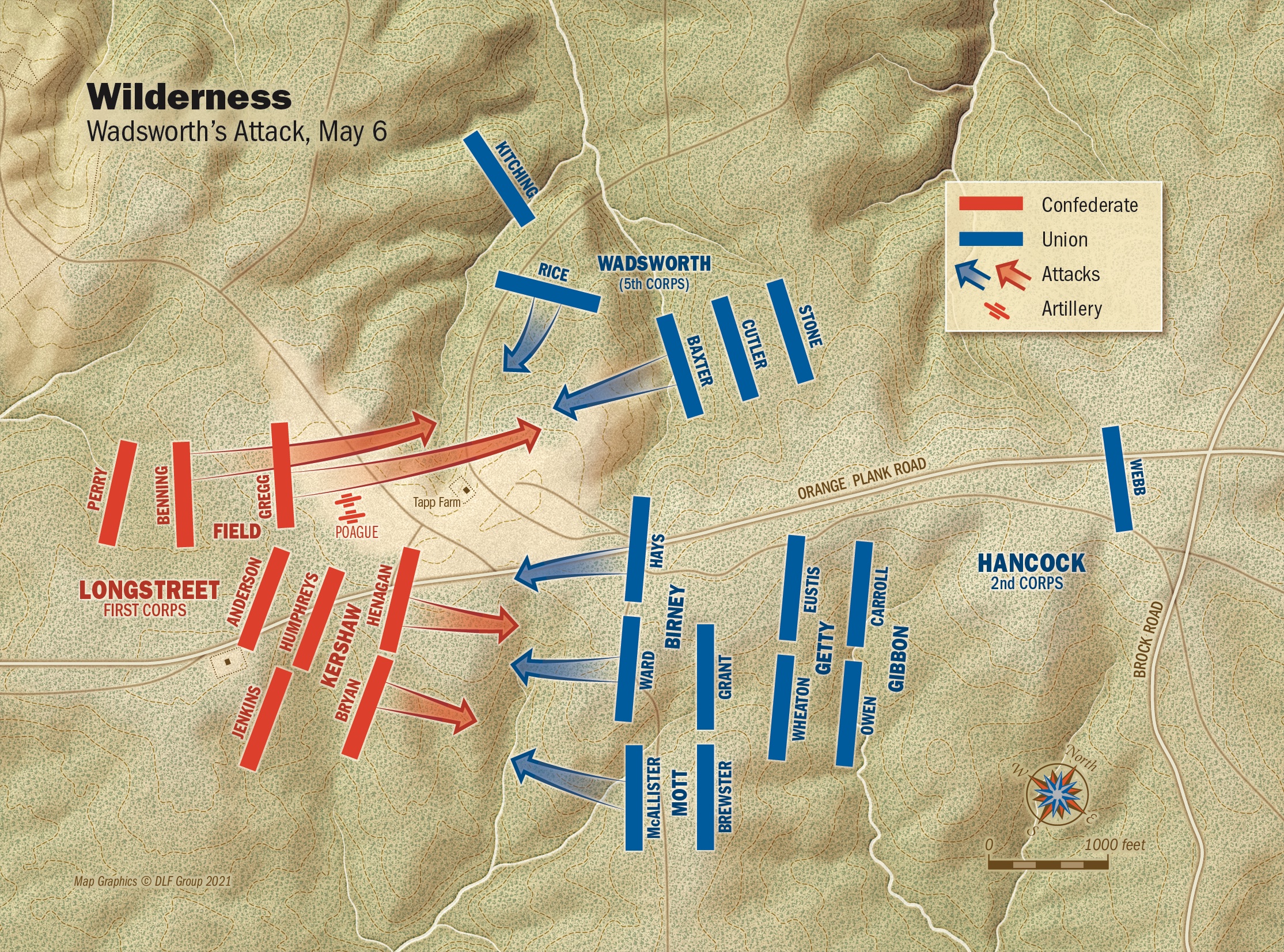
Confederates managed to extract Wadsworth from the field, taking him to the Pulliam Farm, a temporary field hospital roughly 3.5 miles west of where Wadsworth had fallen. There was little doctors could do.
The entry point of the bullet seemed to be in question—near the nose, to the left of the crown of the head, above the forehead—but there was no doubt that the general was insensible and dying. Confederate surgeons made him as comfortable as they could under a tent fly.
“Esteem for his exalted character extended even to his enemies in arms,” one writer said, “the best of who deemed him a worthy foeman.”
Wadsworth had the good fortune to be joined by fellow Union prisoner Major Zabdiel Boylston Adams of the 56th Massachusetts Infantry. While the Battle of the Wilderness had been the baptism of fire for the 56th Massachusetts, it was not the first time Adams has seen the elephant. A doctor, Adams had served with the 7th Massachusetts at First Bull Run, and then joined the 32nd Massachusetts as its surgeon. At Gettysburg, his aid station on the east side of Stony Hill provided quick treatment to Federals battling in the Wheatfield, but the intense work severely damaged his eyes and he was temporarily blinded. Though discharged from the Army, he refused to give up the fight and soon joined the 56th Massachusetts, now attached to the 9th Corps.
A Quick Military Education
James Wadsworth was well aware of his military shortcomings. He initially demurred at a general’s star if it were to come at the expense of a more qualified man. “[A]gainst a graduate of West Point or an officer of the Regular Army of fair reputation…and capacity, I can on no account allow my name to be presented as a candidate,” he said, but added: “[A]gainst men who have no advantage over me but a more recent connexion [sic] with the Militia, and a fresher knowledge of military techniques, I do not think it would be presumptuous in me to offer my name.” What Wadsworth lacked in military training, though, he more than made up for with patriotism, determination, and political connections—connections that eventually led Wadsworth to the post of military governor of Washington, D.C. In this capacity, the New Yorker found himself charged with the defense of the nation’s capital and in close contact with President Lincoln and the Federal high command. The principled Wadsworth soon found himself clashing with civil authorities over enforcement of the Fugitive Slave Law. The general’s antislavery stance colored his interpretation of the law, and he chaffed at the imprisonment of displaced slaves taking refuge in the capital. He also clashed with egotistical Maj. Gen. George B. McClellan after McClellan became Union general in chief. “Little Mac” disdained politicians of any level and so seemed destined for a run-in with Wadsworth. In the spring of 1862, when McClellan shifted the bulk of Union forces to the Virginia Peninsula for a march on Richmond, Wadsworth was anguished McClellan hadn’t left enough men to defend Washington. McClellan balked, claiming he had left 73,456 men behind. The spat drew in Lincoln, who learned the figure was merely 20,000. This steeled the president against sending more troops to the Peninsula despite Little Mac’s pleas. McClellan never forgave Wadsworth for the incident, fuming privately: “I have so thorough a contempt for the man & regard him as…a vile traitorous miscreant.” Wadsworth fared no better with McClellan partisans in the Army, either. “Wadsworth has never taken the field nor exposed his life in the country’s service, but the sphere of his duties are confined to Willard’s Hotel and a comfortable office,” complained Robert S. Robertson of the 93rd New York, “so what has he done?” November 1862 brought elections, including one for the governorship of New York. Wadsworth put his name forward against the wishes of many of the more radical Republicans; however, the same sense of duty that carried Wadsworth off to war kept him there. He stayed at his post, refusing to actively campaign, and would lose to Democrat Horatio Seymour by just fewer than 11,000 votes. The day after the election, Lincoln relieved McClellan of command. As it happened, the same train sent to retrieve McClellan also brought Wadsworth to the army as Lincoln’s special emissary to advise the army’s new commander, Maj. Gen. Ambrose Burnside. “Perhaps it is all right,” said provost marshal Brig. Gen. Marsena Patrick, “but I think the administration adds insult to injury….” When Wadsworth assumed command of the 1st Division in the 1st Corps in December 1862, the appearance of a political general with no military background was met with mixed feelings. “Wadsworth could not be elected Governor,” a Wisconsin soldier complained, “so he must have a place in the army.” But through solid combat experiences at Second Fredericksburg and Gettysburg, “Old Waddy” earned the respect and admiration of his men. During the fatiguing march into Pennsylvania, he cleared shirkers out of ambulances and had men pile knapsacks and guns aboard to lighten their loads. “I was much pleased with Genl Wadsworth,” an admirer opined. “He is a calm, sensible, just and reasonable man, intent upon doing his duty in a sensible and reasonable manner, with no tincture of fanaticism about him, but firm in his hostility to slavery and rebellion.” –C.M. & K.D.W.
James Wadsworth was well aware of his military shortcomings. He initially demurred at a general’s star if it were to come at the expense of a more qualified man. “[A]gainst a graduate of West Point or an officer of the Regular Army of fair reputation…and capacity, I can on no account allow my name to be presented as a candidate,” he said, but added: “[A]gainst men who have no advantage over me but a more recent connexion [sic] with the Militia, and a fresher knowledge of military techniques, I do not think it would be presumptuous in me to offer my name.” What Wadsworth lacked in military training, though, he more than made up for with patriotism, determination, and political connections—connections that eventually led Wadsworth to the post of military governor of Washington, D.C. In this capacity, the New Yorker found himself charged with the defense of the nation’s capital and in close contact with President Lincoln and the Federal high command. The principled Wadsworth soon found himself clashing with civil authorities over enforcement of the Fugitive Slave Law. The general’s antislavery stance colored his interpretation of the law, and he chaffed at the imprisonment of displaced slaves taking refuge in the capital. He also clashed with egotistical Maj. Gen. George B. McClellan after McClellan became Union general in chief. “Little Mac” disdained politicians of any level and so seemed destined for a run-in with Wadsworth. In the spring of 1862, when McClellan shifted the bulk of Union forces to the Virginia Peninsula for a march on Richmond, Wadsworth was anguished McClellan hadn’t left enough men to defend Washington. McClellan balked, claiming he had left 73,456 men behind. The spat drew in Lincoln, who learned the figure was merely 20,000. This steeled the president against sending more troops to the Peninsula despite Little Mac’s pleas. McClellan never forgave Wadsworth for the incident, fuming privately: “I have so thorough a contempt for the man & regard him as…a vile traitorous miscreant.” Wadsworth fared no better with McClellan partisans in the Army, either. “Wadsworth has never taken the field nor exposed his life in the country’s service, but the sphere of his duties are confined to Willard’s Hotel and a comfortable office,” complained Robert S. Robertson of the 93rd New York, “so what has he done?” November 1862 brought elections, including one for the governorship of New York. Wadsworth put his name forward against the wishes of many of the more radical Republicans; however, the same sense of duty that carried Wadsworth off to war kept him there. He stayed at his post, refusing to actively campaign, and would lose to Democrat Horatio Seymour by just fewer than 11,000 votes. The day after the election, Lincoln relieved McClellan of command. As it happened, the same train sent to retrieve McClellan also brought Wadsworth to the army as Lincoln’s special emissary to advise the army’s new commander, Maj. Gen. Ambrose Burnside. “Perhaps it is all right,” said provost marshal Brig. Gen. Marsena Patrick, “but I think the administration adds insult to injury….” When Wadsworth assumed command of the 1st Division in the 1st Corps in December 1862, the appearance of a political general with no military background was met with mixed feelings. “Wadsworth could not be elected Governor,” a Wisconsin soldier complained, “so he must have a place in the army.” But through solid combat experiences at Second Fredericksburg and Gettysburg, “Old Waddy” earned the respect and admiration of his men. During the fatiguing march into Pennsylvania, he cleared shirkers out of ambulances and had men pile knapsacks and guns aboard to lighten their loads. “I was much pleased with Genl Wadsworth,” an admirer opined. “He is a calm, sensible, just and reasonable man, intent upon doing his duty in a sensible and reasonable manner, with no tincture of fanaticism about him, but firm in his hostility to slavery and rebellion.” –C.M. & K.D.W.
Adams and his regiment had fallen under Wadsworth’s temporary command as Longstreet’s flank attack rolled forward. Wounded about the same time as Wadsworth, Adams bribed a Confederate officer with a can of sardines to load him into an ambulance. On the way to the field hospital, however, the ambulance crashed and Adams was knocked unconscious. When he awoke the next day, Adams found himself under an operating table at the Pulliam Farm. Horrifically, he realized bodily fluids were dripping onto his face.
Following a treatment of chloroform and nitric acid, “I found myself lying on the ground beneath a fly tent, and at my side a stretcher on which lay the form of a Union general officer,” Adams recalled. That officer was James Wadsworth.
Given permission to care for Wadsworth, Adams set about examining his patient. The doctor noted “no expression of pain.” One hand held a piece of paper Confederates had given him at the site of his wounding that contained the general’s name, as a way for others to identify him. When Adams took the paper from Wadsworth’s hand, the general would “frown and show restlessness and his hand moved to and fro in search of something.” Having something in his hands or close by seemed to have a calming effect on Wadsworth. Others noted that he played with the triggers and trigger guards of the rifles that held up the blanket that covered him, and a newspaper account noted that Wadsworth’s fingers would play with “the buttons on the coat,” although the reliability of that account is questionable since, by that time, Wadsworth’s coat had been stripped of all buttons.
Confederate surgeons probed the wound, and they attempted to feed the general, but to no avail. According to Adams, the left side of the general’s mouth was drawn down and his right arm was paralyzed.
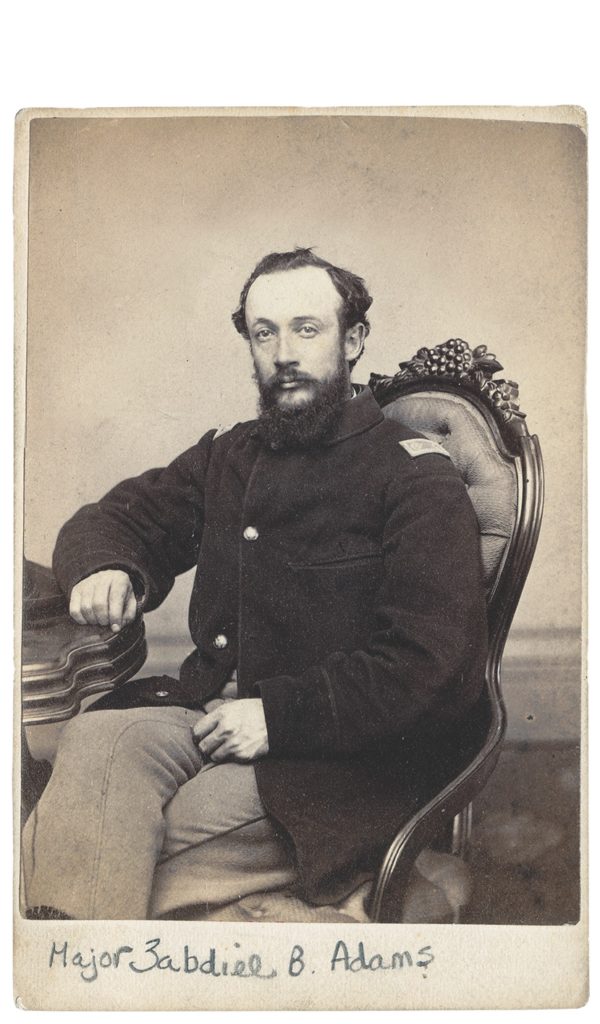
That afternoon, an Irish immigrant, Patrick McCracken, arrived at the Pulliam Farm with food and a bucket of milk. McCracken, a local civilian, had come to see Wadsworth. Under normal circumstances, there was no reason for this Virginia farmer to know the New York millionaire, yet fate had intervened a few years before, and McCracken had come to pay his due.
The first Federal occupation of the Fredericksburg area had spanned from April to August of 1862. During that time, Federal soldiers and local civilians had many uneasy interactions. One such interaction set McCracken on his way to Old Capitol Prison in Washington, D.C., accused of a litany of alleged crimes that ran the gamut from his voting for disunion at the Virginia secession convention to his overseeing the construction of Fort Darling near Richmond. None of the accusations was true. In fact, McCracken was essentially a poor dirt farmer.
The Irishman later recalled he “was a prisoner nine weeks in the Old Capitol [Prison].” Finally, the military governor of Washington at the time—Wadsworth—agreed to hear the man out. Realizing McCracken was innocent, Wadsworth ordered the man released and had the former prisoner swear that he would not support the Confederacy in any capacity. McCracken did so and went home.
In 1864, the 34-year-old McCracken lived “about a mile to the left of the plank road as you go from Fredericksburg to Orange Court House, near New Hope Meeting House…twenty miles from Fredericksburg and eighteen from Orange Court House.” After he heard of Wadsworth’s wounding, McCracken set out for the front and looked to repay “Old Waddy” for his kindness in 1862.
When McCracken arrived, Adams told him that Wadsworth was unable to eat, but McCracken left the milk and food, informing the doctor that he could partake if Wadsworth could not. McCracken also noted the slip of paper in Wadsworth’s hand.
The next day found McCracken at Wadsworth’s side once more. This time, he had “carried some sweet milk to the hospital and wet [Wadsworth’s] lips several times, and let a little go down his mouth. But when the surgeon raised him up, he could not get him to let any go down.” McCracken went home once more.
By the early afternoon of May 8, Wadsworth began to fade. “Here he now lay dying with not a single one of his friends or of kindred, or indeed any one to care for him of the thousands who had been his beneficiaries,” said Adams, who cared for him until the end. “There was only a little scrap of paper to tell who he was….” Just before 2 p.m., Wadsworth died.
But for Patrick McCracken, his debt to the dead Union officer was still not repaid.
Arriving back at the Pulliam Farm, McCracken was informed that Wadsworth was gone. Confederates had placed his body in a box in preparation for burial. McCracken had Wadsworth’s body removed from the hospital and taken to his farm “to bury him in a family burying ground.” There the Irishman “had a coffin made for him” from doors and other materials “painted black.” The makeshift casket was dubbed “a good coffin” by The New York Times when it later arrived in Washington via the Mary Raply.
But first, McCracken interred Wadsworth in his family’s burial plot, where he dug the “chamber” and “covered the coffin with plank, and then dirt.” He also “had a large plank planed and marked for a headstone and placed at the head of his grave,” he informed Wadsworth’s wife, Mary, in a letter dated May 9, 1864. No embalming or arrangements were made, and Old Waddy was buried “with all his clothing, as he fell on the battlefield.”
A Prescient Conversation
Shortly before the Battle of the Wilderness, Wadsworth had a conversation with Brig. Gen. Alexander Webb that proved eerily prescient for both men. “Wadsworth and myself had been discussing why I did not have certain men carried off the field who had been shot in the head,” Webb later recounted in an essay for Battles & Leaders. “I told him that from my observation I had never considered it worthwhile to carry a man off the field if, wounded in the head, he slowly lost his vertical position and was incapable of making a movement of his head from the ground. I considered such cases as past cure.” Wadsworth sustained a mortal head wound on May 6, 1864. On May 12, while fighting at Spotsylvania’s Mule Shoe Salient, Webb likewise received a head wound. “[T]he bullet passed through the corner of my eye and came out behind my ear,” Webb wrote. “While falling from the horse to the ground I [re]called my conversation with General Wadsworth; when I struck the ground I made an effort to raise my head, and when I found I could do so I made up my mind I was not going to die of that wound, and then I fainted.” –C.M. & K.D.W.
Shortly before the Battle of the Wilderness, Wadsworth had a conversation with Brig. Gen. Alexander Webb that proved eerily prescient for both men. “Wadsworth and myself had been discussing why I did not have certain men carried off the field who had been shot in the head,” Webb later recounted in an essay for Battles & Leaders. “I told him that from my observation I had never considered it worthwhile to carry a man off the field if, wounded in the head, he slowly lost his vertical position and was incapable of making a movement of his head from the ground. I considered such cases as past cure.” Wadsworth sustained a mortal head wound on May 6, 1864. On May 12, while fighting at Spotsylvania’s Mule Shoe Salient, Webb likewise received a head wound. “[T]he bullet passed through the corner of my eye and came out behind my ear,” Webb wrote. “While falling from the horse to the ground I [re]called my conversation with General Wadsworth; when I struck the ground I made an effort to raise my head, and when I found I could do so I made up my mind I was not going to die of that wound, and then I fainted.” –C.M. & K.D.W.
But Wadsworth’s body would lie at rest on the McCracken property for only a few days. The Federal high command was anxious to learn of the general’s condition, whether living or dead. Some continued to hold hope that he was still alive. On May 14, the Washington Evening Star reported that a Union prisoner had seen Wadsworth “on a couch in a hospital tent, with one of our officers attending to him”—probably Major Adams. But reports of Wadsworth’s death were circulating. The general’s son, Craig, threatened to ride into enemy lines with or without permission to retrieve his father, dead or alive. Fortunately, cooler heads talked him out of that fool’s errand.
Once Wadsworth’s death had been confirmed, Army of the Potomac commander Maj. Gen. George Gordon Meade wrote directly to his Army of Northern Virginia counterpart, General Robert E. Lee, to request that the body be returned. Although in theory Lee was not opposed to Meade’s request, the Confederate commander refused to allow an exchange or for Federal soldiers to cross into Confederate lines with the intent of obtaining Wadsworth’s remains, given that the campaign was still active.
Nearly a week passed while the high commands of the respective armies tried to come to an agreement. Meanwhile, men in the ranks took it upon themselves to cut through the red tape.
On May 12, Union soldiers under a flag of truce visited the Stephens Farm, a Federal 2nd Corps hospital during the Battle of the Wilderness that had fallen into Confederate hands. There, Captain James C. Borden of the 1st North Carolina Cavalry divulged the whereabouts of Wadsworth’s final resting place. Two days later, a lone ambulance rumbled up to the McCracken house, and Captain Orlando Middleton of the 57th New York had the general’s body exhumed and carried to the port of Fredericksburg. While Meade, Lee, and other ranking officers debated the exhumation and transfer of the body, two line officers and a burial detail found common ground, used common sense, and had faith enough in one another during wartime to trust that there was no ill intent. Thus, Wadsworth’s body was on its way north before Meade and Lee knew exactly what had happened.
The outpouring of public grief over Wadsworth’s death was nearly immediate and spread far and wide. Hundreds of news stories appeared in papers across the country. No detail was too small. Everything from reports of Wadsworth’s wounding, to his medical care, to the retrieval and travel of his body, to the fact that “celebrated embalmers” were dispatched to Fredericksburg, and even down to the fact that the body left Washington, D.C., exactly from the corner of Pennsylvania Avenue and 11th Street for its final journey to New York.
In the next few years, Mary Wadsworth received letters from various members of the Union and Confederate high commands, including Meade, Warren, Andrew Humphreys, and even Lee. Wrote Humphreys, who happened to be Mary’s cousin: “In the two days of desperate fighting that followed our crossing of the Rapidan [River], he was conspicuous beyond all others. Everyone was loud in [their] expressions of admiration at his noble conduct and of the sorrow at his loss.”
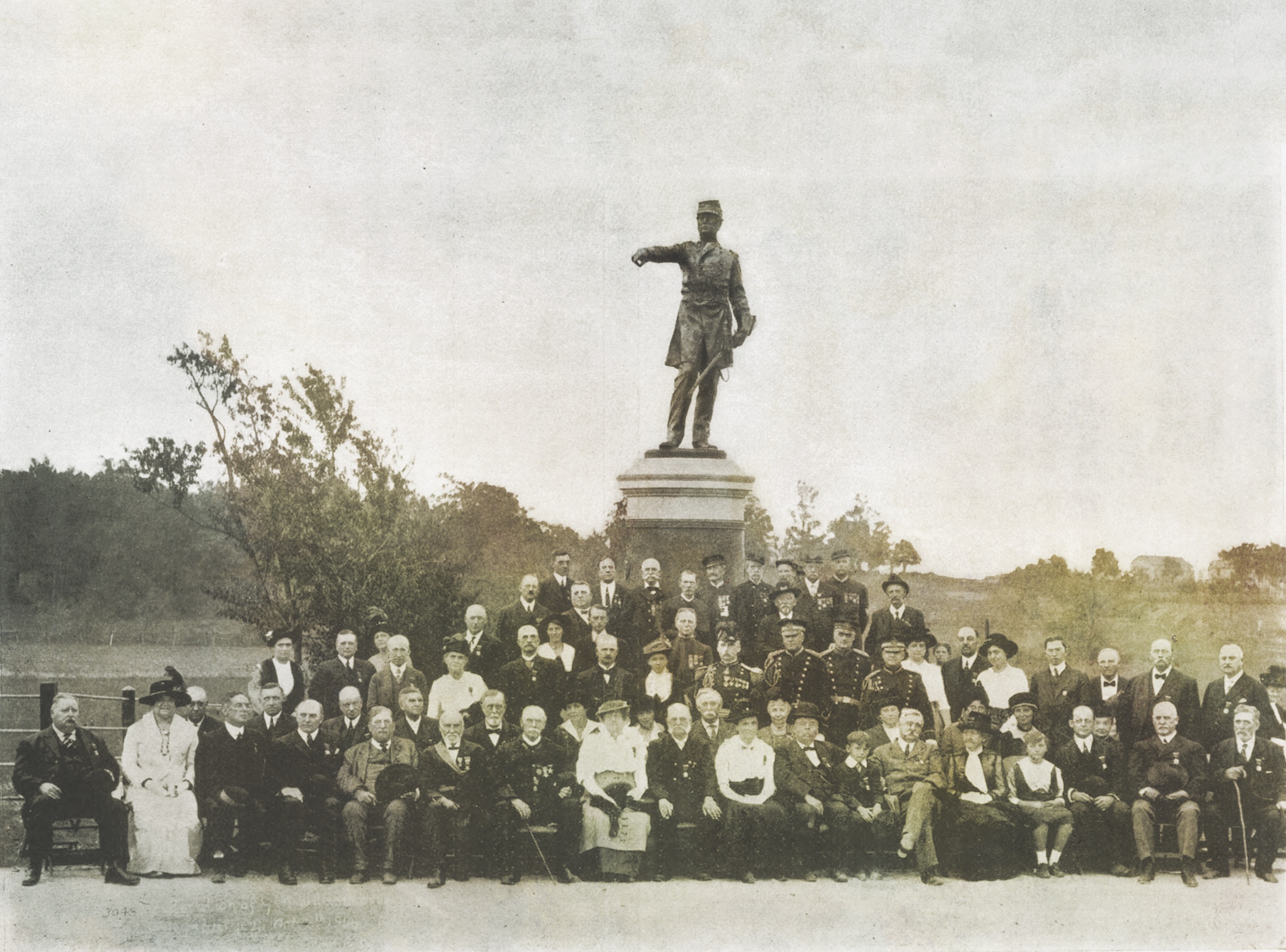
Although Mary Craig Wadsworth had lost her beloved husband, she committed to carrying on his philanthropic spirit, and she never forgot those who helped her husband in his final days—friends and foes alike. Over the years, many of the general’s personal belongings were returned to the family. John Belote, the 6th Virginia soldier who had taken Wadsworth’s gold watch, returned the item to the family and was handsomely rewarded. Adams had cut a lock of the general’s silver hair as a keepsake, which he sent her.
Meanwhile, McCracken’s charity was celebrated across the North, although he was misidentified in some papers as “Patrick Griffin.” Mary Wadsworth felt a special appreciation for what the farmer had done for her husband. The day after the general’s death, McCracken wrote a letter to her outlining the kindness that he, Adams, and the Confederate surgeons had shown in her husband’s twilight hours. Although we do not know the exact amount of “appreciation” Mrs. Wadsworth showered on McCracken, we do know that, in the years following the Civil War, McCracken and his brother, Terrance, opened a thriving dry goods store in Fredericksburg. According to family lore, the money to fund this venture came from Mrs. Wadsworth in appreciation for the kindness bestowed on her husband in May 1864.
Lincoln seemed to feel Wadsworth’s death keenly. “I have not known the President so affected by a personal loss since the death of [Sen. Edward] Baker [at Ball’s Bluff in 1861], as by the death of General Wadsworth,” recorded presidential secretary John Hay.
Wadsworth’s corps commander, Warren, referred to Wadsworth as “his best friend.” Warren went on to write an eloquent and fitting epitaph, which he sent to Mary. “With him, his country stood first, and in the maintenance of her honor and perpetuity, he surrendered the companionship of friends, the comforts and joys of a happy home, and the highest civil honors, and went to meet his foes,” Warren wrote. “With the men of his command he shared all privations and toils and dangers of a soldier’s life. His thoughts were ever for the comfort and efficiency of his troops. It was his nature to lead, and when the shock of battle was heaviest, there was General Wadsworth….[I]n the thickest of the carnage, in the van of his troops, in the very teeth of the enemy he met a patriot’s death.”
Yet it was also there, in the bosom of the enemy, that Wadsworth found compassion in his final hours, inspired by his own decency and humanity. With war still blazing, and the nation’s most powerful men powerless to bring Wadsworth’s body home, an unlikely hero stepped in to show simple human kindness—a kindness that would bind the New York millionaire and the Virginia dirt farmer forever.
Chris Mackowski is a writing professor at St. Bonaventure University in Allegany, N.Y. Kristopher D. White is the senior education manager for the American Battlefield Trust. They are co-founders of Emerging Civil War (www.emergingcivilwar.com).

